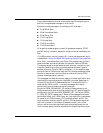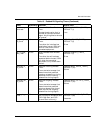
General Information
November 2009 266
The protocols describe the value and meaning of the signaling bits
and the timing between changes in their value.
Brooktrout modules support the following LEC protocols:
E&M Wink Start
E&M Immediate Start
E&M Delay Dial
FXO Loop Start
FXS Loop Start
FXO Ground Start
FXS Ground Start
All signaling modes support pulsed (10 pulses per second), DTMF
and MF dialing. However, detection of digits must be handled by the
host.
ITU's R2 protocol, normally used in E1 lines is also supported, and it
is described in Using the BSMI R2 Signaling Capability on page 336.
Wink Start, Immediate Start and Delay Dial protocols are typically
used to connect equivalent devices (for example, Central Offices).
The same protocol must be loaded on both channel involved in a call.
Loop Start and Ground Start protocols connect different types of
devices (a Central Office or PBX to a Station). In this case the side
acting as Central Office must load the FXO (foreign exchange office)
version of the protocol, while the Station side must load the FXS
(foreign exchange station) version.
The messages and data structures used for the host application and
the module to communicate form the BSMI interface, described in
Volume 5 of the Bfv API Reference Manual. The same Bfv API is
used also for ISDN and R2 — the same messages are used to
control/notify similar events across all protocols.
Structure IISDN_BCHANNEL_ID contains fields common to all
CAS protocols plus data structures containing LEC- and R2-specific
configuration (structures IISDN_ROBBED_BIT_DATA and IISDN_
E1_CAS_R2_DATA respectively). Some of the message fields have
names that reflect their ISDN roots, but their definition is extended
for use with all CAS protocols (LEC protocols as well as R2). The
most important ones are lapdid, which in CAS protocols identifies
the trunk number in the module (0-based) and call_ref, a 16-bit
value in which the most-significant byte must always contain the
trunk number (same value as lapdid) and the least significant byte


















